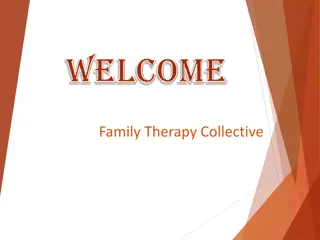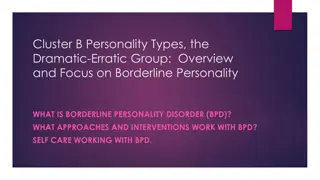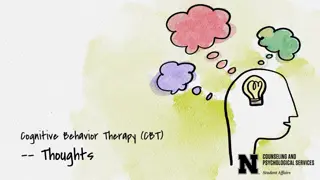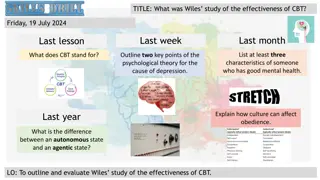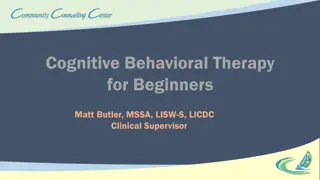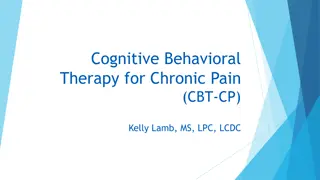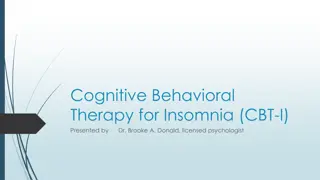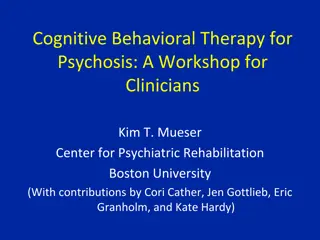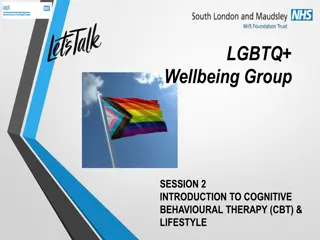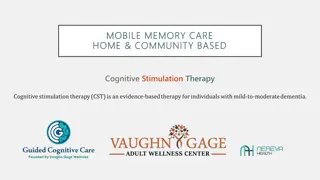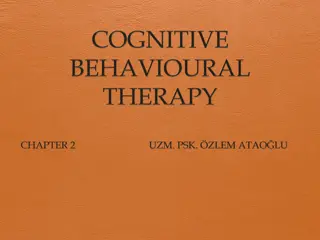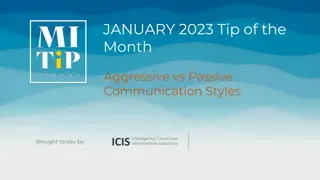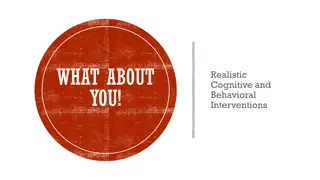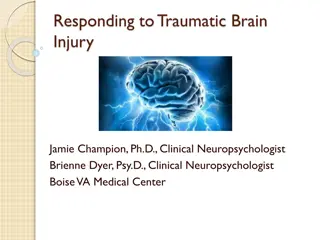Understanding Cognitive Behavioral Therapy (CBT) by Dr. James Ikonomopoulos
Explore the foundations and application of Cognitive Behavioral Therapy (CBT) through the work of Dr. James Ikonomopoulos. Uncover the connection between thoughts, feelings, and behaviors, learn cognitive and behavioral interventions for children and adults, and delve into the cognitive model of therapy pioneered by Aaron T. Beck in the 1960s.
Download Presentation

Please find below an Image/Link to download the presentation.
The content on the website is provided AS IS for your information and personal use only. It may not be sold, licensed, or shared on other websites without obtaining consent from the author. Download presentation by click this link. If you encounter any issues during the download, it is possible that the publisher has removed the file from their server.
E N D
Presentation Transcript
Presentation Objectives Explain the connection between thoughts, feelings, and behaviors Develop a cognitive case conceptualization and understand its relationship to Cognitive Therapy Choose and apply cognitive interventions appropriate for use with children and adults Choose and apply behavioral interventions appropriate for use with children and adults
Outline of Presentation Introduction to CBT Basic principles and overview of treatment Cognitive Conceptualization The cognitive model The Evaluation Session Intake and assessment The Initial Therapy Session Treatment Planning The 2ndSession and Beyond
Outline of Concepts Behavioral Activation Identifying Automatic Thoughts Identifying Emotions Evaluating Automatic Thoughts Responding to Automatic Thoughts Identifying and Modifying Intermediate Beliefs Identifying and Modifying Core Beliefs Imagery Homework Additional Techniques
Introduction to CBT A revolution in the field of mental health was started in the 1960 s by Aaron T. Beck He began as a fully trained and practicing Psychoanalyst. He was a scientist at heart, believed theories should be empirically valid. Began studying depression, and results of his experiments lead him to pursue other explanations for depression.
What is CBT? Dr. Beck decided to test the psychoanalytic concept that depression is the result of hostility turned inward toward the self. He investigated the dreams of depressed patients, which, he predicted, would manifest greater themes of hostility than the dreams of normal control patients. To his surprise, he ultimately found that the dreams of depressed patients contained fewer themes of hostility and far greater themes of defectiveness, deprivation, and loss. He recognized that these themes paralleled his patients thinking when they were awake.
What is CBT? He identified distorted, negative cognition (primarily thoughts and beliefs) as a primary feature of depression and developed a short-term treatment, one of whose primary targets was the reality testing of patients depressed thinking. Aaron Beck developed a form of psychotherapy in the early 1960s that he originally termed cognitive therapy. Cognitive therapy is now used synonymously with cognitive behavior therapy by much of our field.
What is CBT? Beck devised a structured, short-term, present- oriented psychotherapy for depression, directed toward solving current problems and modifying dysfunctional (inaccurate and/or unhelpful) thinking and behavior (Beck, 1964). Since that time, he and others have successfully adapted this therapy to a surprisingly diverse set of populations with a wide range of disorders and problems. These adaptations have changed the focus, techniques, and length of treatment, but the theoretical assumptions themselves have remained constant.
What is CBT? In all forms of cognitive behavior therapy that are derived from Beck s model, treatment is based on a cognitive formulation, the beliefs and behavioral strategies that characterize a specific disorder (Alford & Beck, 1997). Treatment is also based on a conceptualization, or understanding, of individual patients (their specific beliefs and patterns of behavior). The therapist seeks in a variety of ways to produce cognitive change modification in the patient s thinking and belief system to bring about enduring emotional and behavioral change.
What is CBT? Beck drew on a number of different sources when he developed this form of psychotherapy, including early philosophers, such as Epicetus, and theorists, such as Karen Horney, Alfred Adler, George Kelly, Albert Ellis, Richard Lazarus, and Albert Bandura. Beck s work, has been expanded by current researchers and theorists, in the United States and abroad.
Different Forms of CBT There are a number of forms of cognitive behavior therapy that share characteristics of Beck s therapy, but whose conceptualizations and emphases in treatment vary to some degree. These include rational emotional behavior therapy (Ellis, 1962), dialectical behavior therapy (Linehan, 1993), problem- solving therapy (D Zurilla & Nezu, 2006), acceptance and commitment therapy (Hayes, Follette, & Linehan, 2004), exposure therapy (Foa & Rothbaum, 1998), cognitive processing therapy (Resick & Schnicke, 1993), cognitive behavioral analysis system of psychotherapy (McCullough, 1999), behavioral activation (Lewinsohn, Sullivan, & Grosscup, 1980; Martell, Addis, & Jacobson, 2001), cognitive behavior modification (Meichenbaum, 1977), TF-CBT (Cohen, Mannarino, & Knudsen, 2004; Cohen,. Mannarino, & Staron, 2006), and others. Beck s cognitive behavior therapy often incorporates techniques from all these therapies, and other psychotherapies, within a cognitive framework.
The Cognitive Model Men are disturbed not by things, but by the view which they take of them. - Epictetus It s not the situations in our lives that cause distress, but rather our interpretations of those situations. Aaron T. Beck
What is the Theory of CBT? The cognitive model proposes that dysfunctional thinking (which influences the patient s mood and behavior) is common to all psychological disturbances. When people learn to evaluate their thinking in a more realistic and adaptive way, they experience improvement in their emotional state and in their behavior. For example, if you were quite depressed and bounced some checks, you might have an automatic thought, an idea that just seemed to pop up in your mind: I can t do anything right. This thought might then lead to a particular reaction: you might feel sad (emotion) and retreat to bed (behavior). If you then examined the validity of this idea, you might conclude that you had overgeneralized and that, in fact, you actually do many things well. Looking at your experience from this new perspective would probably make you feel better and lead to more functional behavior.
What is the Theory of CBT? For lasting improvement in patients mood and behavior, cognitive therapists work at a deeper level of cognition: patients basic beliefs about themselves, their world, and other people. Modification of their underlying dysfunctional beliefs produces more enduring change. For example, if you continually underestimate your abilities, you might have an underlying belief of incompetence. Modifying this general belief (i.e., seeing yourself in a more realistic light as having both strengths and weaknesses) can alter your perception of specific situations that you encounter daily. You will no longer have as many thoughts with the theme, I can t do anything right. Instead, in specific situations where you make mistakes, you will probably think, I m not good at this [specific task].
What Does the Research Say? Cognitive behavior therapy has been extensively tested since the first outcome study was published in 1977 (Rush, Beck, Kovacs, & Hollon, 1977). At this point, more than 500 outcome studies have demonstrated the efficacy of cognitive behavior therapy for a wide range of psychiatric disorders, psychological problems, and medical problems with psychological components (see, e.g., Butler, Chapman, Forman, & Beck, 2005; Chambless & Ollendick, 2001).
Partial List of Disorders Successfully Treated by CBT Couple problems Family problems Pathological gambling Complicated grief Caregiver distress Anger and hostility Chronic back pain Sickle cell disease pain Migraine headaches Tinnitus Cancer pain Somatoform disorders Irritable bowel syndrome Chronic fatigue syndrome Rheumatic disease pain Erectile dysfunction Insomnia Obesity Vulvodynia Hypertension Gulf War syndrome (PTSD and more) Bipolar disorder (with medication) Schizophrenia (with medication) Psychiatric disorders Major depressive disorder Geriatric depression Generalized anxiety disorder Geriatric anxiety Panic disorder Agoraphobia Social phobia Obsessive compulsive disorder Conduct disorder Substance abuse Attention-deficit/hyperactivity disorder Health anxiety Body dysmorphic disorder Eating disorders Personality disorders Sex addiction Habit disorders
General Principles of CBT Cognitive behavioral therapy is: Semi structured, time sensitive, active; Based on a case conceptualization; Focused on skill development; and Oriented toward a hypothesis testing approach. Clinician and client work collaboratively with a focus on a strong relationship. All interventions aim at cognitive change.
General Principles of CBT Principle No. 1. Cognitive behavior therapy is based on an ever-evolving formulation of patients problems and an individual conceptualization of each patient in cognitive terms. Principle No. 2. Cognitive behavior therapy requires a sound therapeutic alliance. Principle No. 3. Cognitive behavior therapy emphasizes collaboration and active participation. Principle No. 4. Cognitive behavior therapy is goal oriented and problem focused.
General Principles of CBT Principle No. 5. Cognitive behavior therapy initially emphasizes the present. Principle No. 6. Cognitive behavior therapy is educative, aims to teach the patient to be her own therapist, and emphasizes relapse prevention. Principle No. 7. Cognitive behavior therapy aims to be time limited. Principle No. 8. Cognitive behavior therapy sessions are structured.
General Principles of CBT Principle No. 9. Cognitive behavior therapy teaches patients to identify, evaluate, and respond to their dysfunctional thoughts and beliefs. Principle No. 10. Cognitive behavior therapy uses a variety of techniques to change thinking, mood, and behavior.
Importance of the Therapeutic Relationship Like most other therapies, the therapeutic relationship is a necessary and critical component of CBT: Empathic Understanding Warm Genuine Direct and sensitive
The Cognitive Model Your client has been sent to the office for the 4th time this week! The family has not returned your calls, and the client is refusing to talk to you. What do you think? How do you feel? What do you do?
The Situation The Beliefs The Consequences This kid is so frustrating! He isn t even trying to get better! Feelings of Frustration The client no-shows for his session again His family situation is so tough right now, it s really hard for him to get to sessions. Feelings of Compassion
Situation Thoughts Behaviors Feelings
Thinking, Feeling, and Behaving THOUGHTS FEELINGS BEHAVIORS
Situation Get a dirty look from another kid Behaviors Automatic Thought Threaten the kid Punch the kid Refuse to back down He thinks he s tougher than me. I ll have to show him I m not a punk Feelings Angry and Offended
Cognitive Model: Situations A situation or activating event may be an internal or external event that prompts an automatic thought. External event: alarm clock ringing, being interrupted, called on in class Internal event: memory, thought, emotion, sensation
Cognitive Model: Beliefs AUTOMATIC THOUGHTS Quick evaluative thoughts INTERMEDIATE BELIEFS Rules or assumptions about life If________, then_____. CORE BELIEFS Deeply held, rigid beliefs about the self, others, and the world
Cognitive Model: Automatic Thoughts Quick, evaluative thoughts or images that are situation specific Automatic thoughts = interpretations We are more likely to be aware of the emotion that follows an automatic thought.
Automatic Thoughts When you notice a strong reaction (emotional, behavioral, physiological), ask yourself: What was going through my mind just then?
Eliciting Automatic Thoughts 1. Ask them how they are/were feeling and where in their body they experienced the emotion. 2. Elicit a detailed description of the problematic situation. 3. Request that the patient visualize the distressing situation. 4. Suggest that the patient role-play the specific interaction with you (if the distressing situation was interpersonal). 5. Elicit an image. 6. Supply thoughts similar or opposite to the ones you hypothesize actually went through their minds. 7. Ask for the meaning of the situation. 8. Phrase the question differently.
Intermediate Beliefs Attitudes, rules, or assumptions that stem from core beliefs and fuel automatic thoughts Commonly in the form of if/then statements If I can t do this perfectly, then why bother trying? If I open up to people, then I will get hurt.
Core Beliefs MOST CENTRAL, FUNDAMENTAL BELIEFS ABOUT OURSELVES, OTHERS, AND THE WORLD Absolute and rigid beliefs (+ or ) in 1 2 words I m worthless. May result in biases in attention, information processing, and memory. When activated, we interpret situations through the lens of this belief. Not necessarily accurate or helpful
How Core Beliefs Impact Thoughts Core Belief: I am Stupid Core Belief: I am Smart Event: Hears that a hard math test is scheduled for next week Automatic Thoughts and Images I ll really have to pay attention and ask for help This is too hard, I ll never understand this. Reaction and Behaviors Sad, gives up, avoids studying, ultimately fails Feels determined, seeks out help, studies, passes
Inaccurate and Unhelpful Beliefs WORTHLESS I am bad. I am a waste. UNLOVABLE I am a burden. I am disgusting. No one wants me. HELPLESS People hate me. I am incompetent. I am vulnerable. I am not good enough.
Common Unhelpful Thoughts 1. All-or-nothing thinking (also called black-and-white, polarized, or dichotomous thinking): You view a situation in only two categories instead of on a continuum. Example: If I m not a total success, I m a failure. 2. Catastrophizing (also called fortune-telling): You predict the future negatively without considering other, more likely outcomes. Example: I ll be so upset, I won t be able to function at all. 3. Disqualifying or discounting the positive: You unreasonably tell yourself that positive experiences, deeds, or qualities do not count. Example: I did that project well, but that doesn t mean I m competent; I just got lucky. 4. Emotional reasoning: You think something must be true because you feel (actually believe) it so strongly, ignoring or discounting evidence to the contrary. Example: I know I do a lot of things okay at work, but I still feel like I m a failure. 5. Labeling: You put a fixed, global label on yourself or others without considering that the evidence might more reasonably lead to a less disastrous conclusion. Example: I m a loser. He s no good.
Common Unhelpful Thoughts 6. Magnification/minimization: When you evaluate yourself, another person, or a situation, you unreasonably magnify the negative and/or minimize the positive. Example: Getting a mediocre evaluation proves how inadequate I am. Getting high marks doesn t mean I m smart. 7. Mental filter (also called selective abstraction): You pay undue attention to one negative detail instead of seeing the whole picture. Example: Because I got one low rating on my evaluation [which also contained several high ratings] it means I m doing a lousy job. 8. Mind reading: You believe you know what others are thinking, failing to consider other, more likely possibilities. Example: He thinks that I don t know the first thing about this project. 9. Overgeneralization: You make a sweeping negative conclusion that goes far beyond the current situation. Example: [Because I felt uncomfortable at the meeting] I don t have what it takes to make friends.
Common Unhelpful Thoughts 10. Personalization: You believe others are behaving negatively because of you, without considering more plausible explanations for their behavior. Example: The repairman was curt to me because I did something wrong. 11. Should and must statements (also called imperatives): You have a precise, fixed idea of how you or others should behave, and you overestimate how bad it is that these expectations are not met. Example: It s terrible that I made a mistake. I should always do my best. 12. Tunnel vision: You only see the negative aspects of a situation. Example: My son s teacher can t do anything right. He s critical and insensitive and lousy at teaching.
Coping Strategies Behaviors that the client engages in that either support or oppose beliefs Strategies may involve thinking or doing something.
Coping Strategies Maintaining Strategies Opposing Strategies Avoiding Strategies Try to prove the belief is wrong Try not to activate the belief Support the Core Belief Behavior generally makes sense to the person doing it, based on how they see the world, others, and themselves.
Coping Strategies Belief I m unlovable Maintaining Strategies Opposing Strategies Avoiding Strategies Try to prove the belief is wrong Try not to activate the belief Support the Belief Acting in a hostile manner People Pleasing Isolating
Beliefs and Strategies NAME SOME CLIENT BEHAVIORS What kinds of beliefs might be associated with these behaviors? WHAT KINDS OF BEHAVIOR MIGHT BE ASSOCIATED WITH THESE BELIEFS? I m vulnerable. I have no control. Everyone is trying to hurt me.
Case Conceptualization Foundation of CBT treatment Brings together all the information into one coherent story Takes into consideration life experiences that lead us to think and behave in specific ways Based on here and now functioning and symptoms
Case Conceptualization Why use case conceptualization? To better understand behavior To increase empathy To identify ways to engage clients To identify targets for intervention To create a shared understanding of a child or adolescent
Case Conceptualization History: Critical and abusive family members, undiagnosed learning disability, neglect CoreBeliefs: I m worthless. I m stupid. People are dangerous. IntermediateBeliefs: It is horrible to make mistakes. If I hurt people first, then they can t hurt me. Coping Strategies and Behaviors: Avoid challenging situations, aggression, isolation.
Case Vignette: Michele Please read the vignette about Michele. When you are finished, please review the case conceptualization. WHAT ARE THE IMPORTANT FACTS FROM HER PAST? WHAT ARE HER BELIEFS? WHICH EMOTIONS AND BEHAVIOR DOES SHE HAVE, AND HOW ARE THEY RELATED TO HER BELIEFS? Please be ready to discuss with your group.
Session Structure Mood check & general assessment Bridge from the previous session Agenda setting Homework review Discussion of issues on the agenda Summary and feedback (periodic summaries and homework assignment)
Behavioral Activation Situation: Thinking about initiating an activity [Common] Automatic thoughts: I m too tired. I won t enjoy it. My friends won t want to spend time with me. I won t be able to do it. Nothing can help me feel better. [Common] Emotional reactions: Sadness, anxiety, hopelessness [Common] Behavior: Remain inactive.



